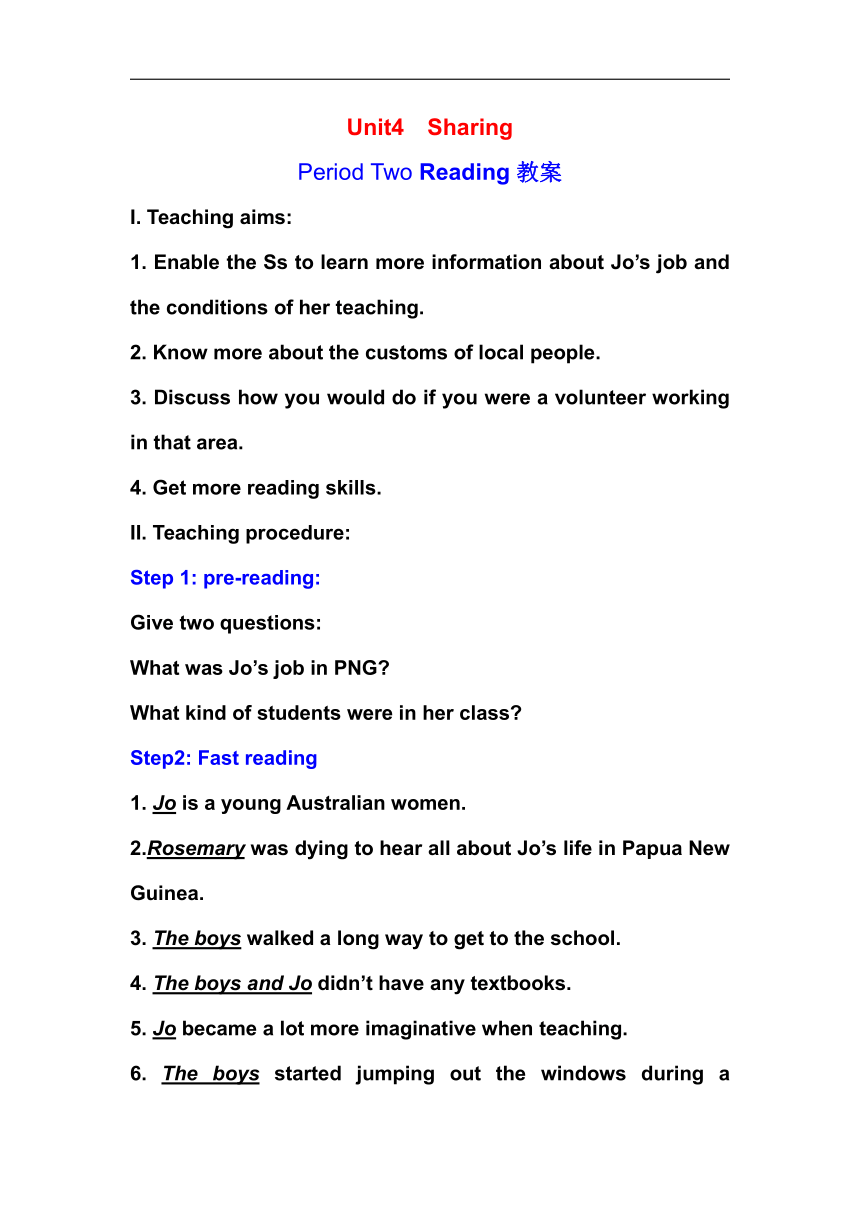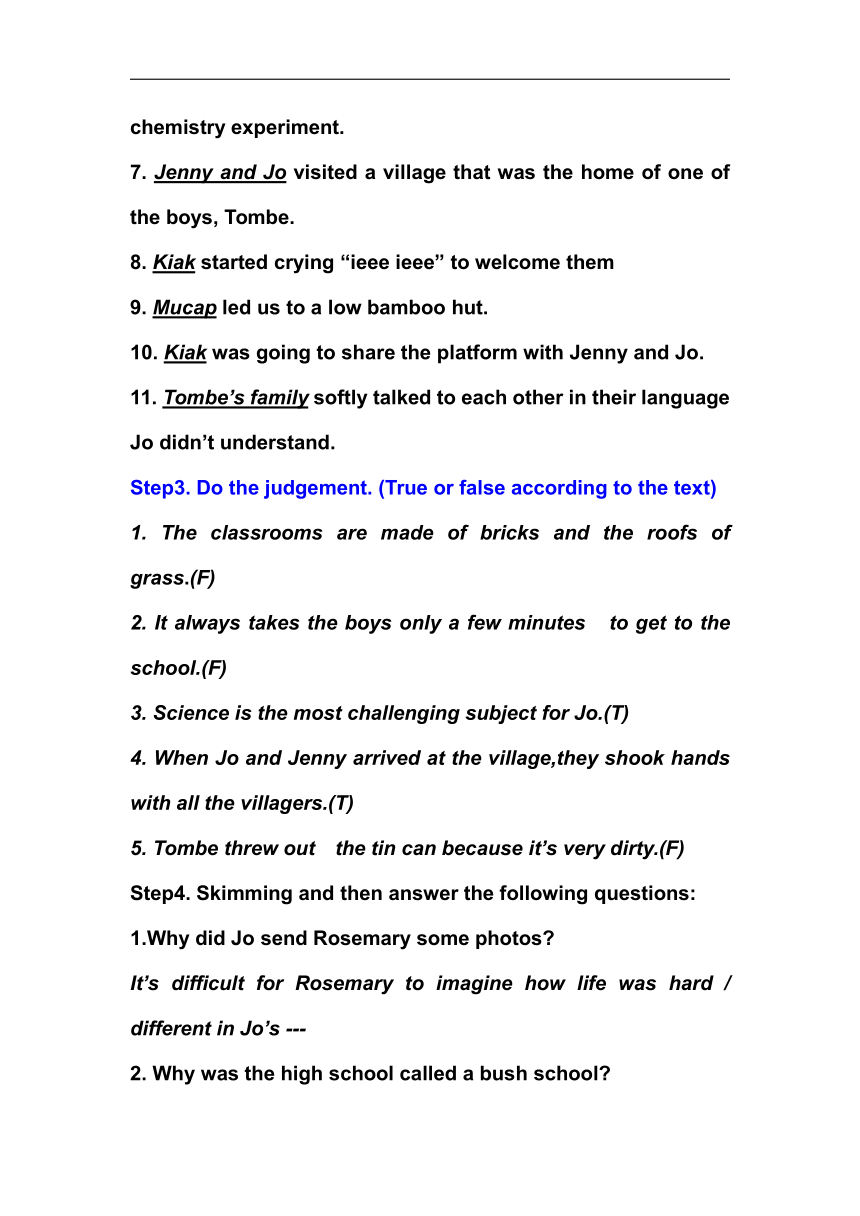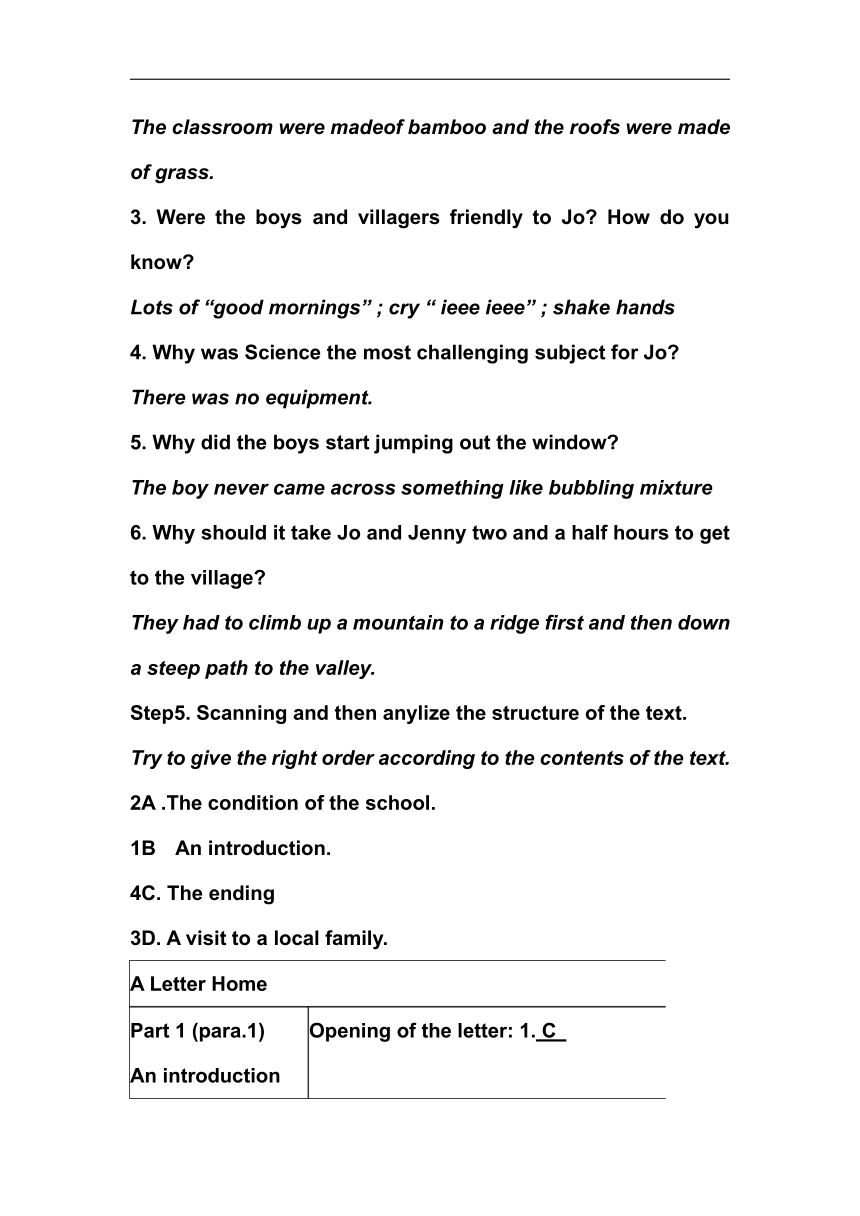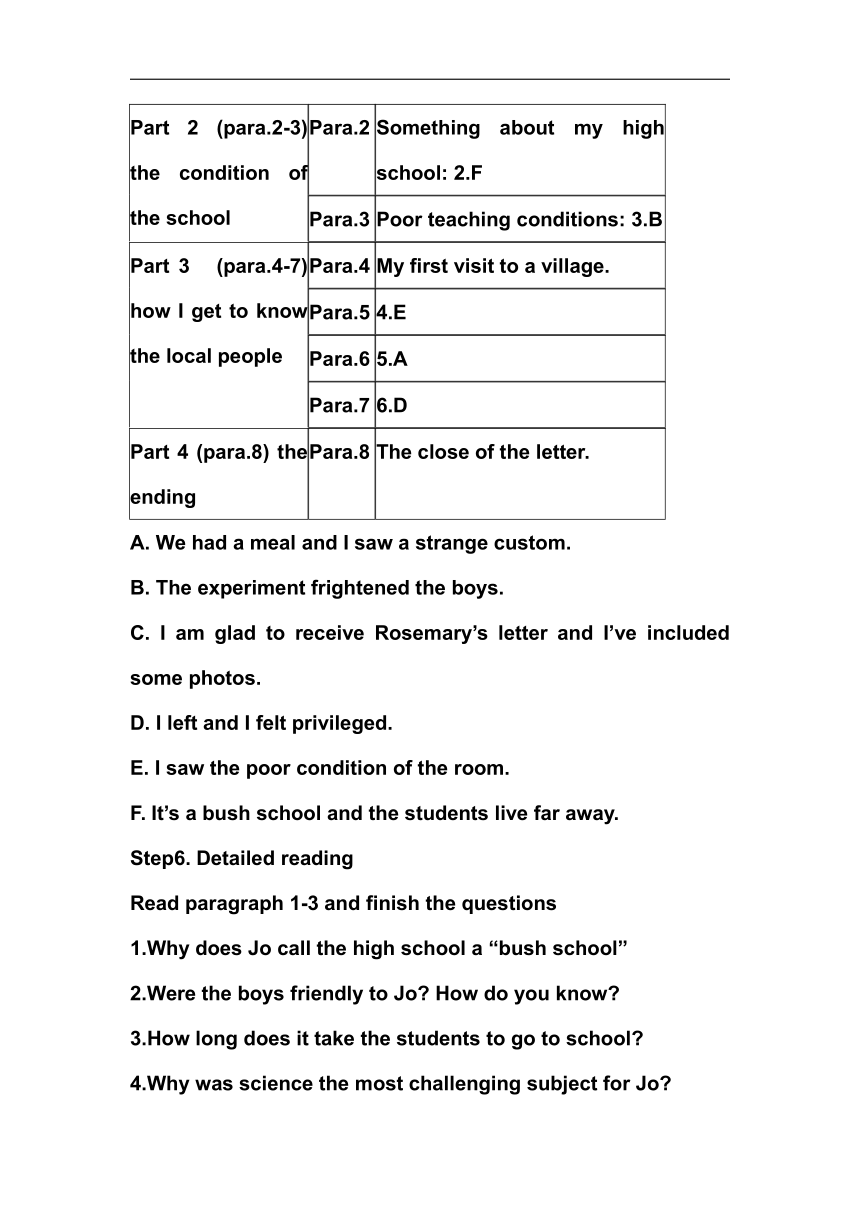人教新课标高二英语选修七 Unit4 Sharing reading教案
文档属性
| 名称 | 人教新课标高二英语选修七 Unit4 Sharing reading教案 |  | |
| 格式 | zip | ||
| 文件大小 | 16.8KB | ||
| 资源类型 | 教案 | ||
| 版本资源 | 人教版(新课程标准) | ||
| 科目 | 英语 | ||
| 更新时间 | 2019-10-16 11:09:08 | ||
图片预览





文档简介
Unit4 Sharing
Period Two Reading教案
I. Teaching aims:
1. Enable the Ss to learn more information about Jo’s job and the conditions of her teaching.
2. Know more about the customs of local people.
3. Discuss how you would do if you were a volunteer working in that area.
4. Get more reading skills.
II. Teaching procedure:
Step 1: pre-reading:
Give two questions:
What was Jo’s job in PNG?
What kind of students were in her class?
Step2: Fast reading
1. Jo is a young Australian women.
2.Rosemary was dying to hear all about Jo’s life in Papua New Guinea.
3. The boys walked a long way to get to the school.
4. The boys and Jo didn’t have any textbooks.
5. Jo became a lot more imaginative when teaching.
6. The boys started jumping out the windows during a chemistry experiment.
7. Jenny and Jo visited a village that was the home of one of the boys, Tombe.
8. Kiak started crying “ieee ieee” to welcome them
9. Mucap led us to a low bamboo hut.
10. Kiak was going to share the platform with Jenny and Jo.
11. Tombe’s family softly talked to each other in their language Jo didn’t understand.
Step3. Do the judgement. (True or false according to the text)
1. The classrooms are made of bricks and the roofs of grass.(F)
2. It always takes the boys only a few minutes to get to the school.(F)
3. Science is the most challenging subject for Jo.(T)
4. When Jo and Jenny arrived at the village,they shook hands with all the villagers.(T)
5. Tombe threw out the tin can because it’s very dirty.(F)
Step4. Skimming and then answer the following questions:
1.Why did Jo send Rosemary some photos?
It’s difficult for Rosemary to imagine how life was hard / different in Jo’s ---
2. Why was the high school called a bush school?
The classroom were madeof bamboo and the roofs were made of grass.
3. Were the boys and villagers friendly to Jo? How do you know?
Lots of “good mornings” ; cry “ ieee ieee” ; shake hands
4. Why was Science the most challenging subject for Jo?
There was no equipment.
5. Why did the boys start jumping out the window?
The boy never came across something like bubbling mixture
6. Why should it take Jo and Jenny two and a half hours to get to the village?
They had to climb up a mountain to a ridge first and then down a steep path to the valley.
Step5. Scanning and then anylize the structure of the text.
Try to give the right order according to the contents of the text.
2A .The condition of the school.
1B An introduction.
4C. The ending
3D. A visit to a local family.
A Letter Home
Part 1 (para.1)
An introduction
Opening of the letter: 1. C
Part 2 (para.2-3) the condition of the school
Para.2
Something about my high school: 2.F
Para.3
Poor teaching conditions: 3.B
Part 3 (para.4-7) how I get to know the local people
Para.4
My first visit to a village.
Para.5
4.E
Para.6
5.A
Para.7
6.D
Part 4 (para.8) the ending
Para.8
The close of the letter.
A. We had a meal and I saw a strange custom.
B. The experiment frightened the boys.
C. I am glad to receive Rosemary’s letter and I’ve included some photos.
D. I left and I felt privileged.
E. I saw the poor condition of the room.
F. It’s a bush school and the students live far away.
Step6. Detailed reading
Read paragraph 1-3 and finish the questions
1.Why does Jo call the high school a “bush school”
2.Were the boys friendly to Jo? How do you know?
3.How long does it take the students to go to school?
4.Why was science the most challenging subject for Jo?
5.Why did the boys start jumping out of the windows?
6.Why does Jo wonder how relevant chemistry is to the kids?
Read paragraph 1-3 and finish the questions
1.Why does Jo call the high school a “bush school”
Because the classrooms are made from bamboo and the roofs from grass.
2.Were the boys friendly to Jo? How do you know?
There are a lot of “good mornings” for Jo from the boys.
3.How long does it take the students to go to school?
Sometimes up to 2 hours
4.Why was science the most challenging subject for Jo?
There was no equipment.
5.Why did the boys start jumping out of the windows?
The boys never came across anything like the bubbling mixture.
6.Why does Jo wonder how relevant chemistry is to the kids?
Because most of the boys will go back to their villages after year 8 and she thinks chemistry may make little difference to the kids’ life.
Step7. Comprehending
What have you learned about the customs and lives of the people in Tombe’s village? Read Jo’s letter and look at her photos. Then complete the table below:
Type of houses
Men’s hut is a low bamboo hut with grass sticking out of the roof. No windows, small doorway. Floor was covered with fresh grass.
Family relationships
Everyone seemed to be a relative of Tombe’s. (large extended family)
Cooking methods
Hot stonesare placed in an oil drum, then vegetables are placed in the drum, covered with banana leaves and steamed.
Sleeping arrangements
Kiak usually slept in her own hut. A newly made platform for Jenny and me to sleep on.
Diet
sweet potato, corns and greens.
Possessions
I could only see one broom a few tin plates and cups and a couple of jars.
Agriculture
Tools are very basic. There is no machinery.
Beliefs
The villagers believe in evil spirits. They believe that leftover food attracts evil spirits so that dry it out in a can over the fire.
Step8. Post-reading
Guess the reasons for the facts according to the Jo’s letter.
1. The boys jumped out of the windows in the science lesson.
In the science lesson the boys were frightened by what they saw --- the mixture was bubbling over everywhere, thinking that something terrible had happened, so they jumped out of the windows to escape from danger.
2. Jo wondered how relevant chemistry was to the boys.
Because most of the boys will go back to their village after studying in the school, and their knowledge of chemistry will prove useless, so Jo wondered how relevant chemistry was to the boys.
3. Tombe’s mother cried “ieee ieee” when he say Jo.
I think it’s a kind of greeting in their village. And I’m sure all the family members will be happy and excited to have visitors like Jenny and Jo.
4. There were no windows in Mukap’s hut.
There were no windows in Mukap’s hut. Perhaps in this way can prevent flies, mosquitoes and other insects from coming in. Of course, if there were glass, they could both have a big window, and at the same time, they can keep all the insects from entering.
5. The tin can was standing upside down on the grill.
The tin can was standing upside down on the grill in order to get the leftover dry up quickly.
Step9. Fill in the chart:
What do you think are the positive and negative things about living in a village in Papua New Guinea. The first one is done for you.
Positive aspects
Negative aspects
1. Boys value education
1. No running water or electricity
2.Every one would know each other
2. Have no roads to connect with outside world
3. Does not have to rely on outside sources for food
3. Have to walk a long way to the closest school
4. People can live without many possessions
4. There might not be any medical services close by
Step10. Discussion in groups:
1. Compare the differences between our school and the school described in the letter
Conditions
Our school
The school described in the letter
Classrooms
(equipment or no)
?Equipment
?No equipment
Students’ future
?Go to college or work
?Return to the villages
Electricity and water
(Y/N)
?Yes
?No
Textbook (Y/N)
?Yes
?No
Chemistry experiments
(many/few)
?Many
?Few
2. Jo felt it was a privilege to have spent a day with Tombe’s family. If you were Jo, how do you think you would have felt? Give reasons.
First I think it was such a long distance from the school to Tombe’s home. Second, the family members and the villagers showed great hospitality to us, which impressed us very deeply. Third, we got the chance to know the villager’s simple life. Therefore, we were determined to go on with volunteer work to help the boys get enough education
3.Why do you think Jo became a volunteer in PNG? Give as many possible reasons as you can. Would you like to work as a volunteer in a poor area?Give reasons.
Useful phrases: be willing to; do one’s bit to do; be eager to do; be full of ; work hard and endure hardship…
Key words: kind-hearted; helpful; strong-minded
A sample of the discussions:
A: I think, first of all, Jo was a kind-hearted woman, who is willing to help others. Second, she knew enough about the poor conditions in PNG and thought that she could help teach in the schools. IfI am given the chance, I will do whatever I can to help.
B: In my opinion, Jo must have worked as a teacher in Australia, and she applied to become a volunteer abroad, and then she was sent to PNG as a volunteer.
C: Maybe she thinks that education is the key to solving all the problems in PNG, so she, as a teacher, goes to PNG to help.
D: Perhaps she likes traveling abroad, helping the poor wherever she goes.
E: I don’t agree with you. You know, she stayed there for two years. A traveler once did that. She was willing to help the poor children in PNG to be educated. She was doing her bit to change the poor’s state of living and education. Ifeveryone in the rich countries should do like her, all the problems stemming from poverty could be solved easily.
F: I would like to say something about the second topic. I think I will be a volunteer in a poor area. Whenever I saw the poor living state of the poor in the western areas and mountainous areas, I was eager to do something for them. All are created equal. But they can’t get what we can enjoy. What a pity! If possible, I will try to help
Step11.Homework:
Surf the Internet to find some information about the volunteers working in poor areas.
Period Two Reading教案
I. Teaching aims:
1. Enable the Ss to learn more information about Jo’s job and the conditions of her teaching.
2. Know more about the customs of local people.
3. Discuss how you would do if you were a volunteer working in that area.
4. Get more reading skills.
II. Teaching procedure:
Step 1: pre-reading:
Give two questions:
What was Jo’s job in PNG?
What kind of students were in her class?
Step2: Fast reading
1. Jo is a young Australian women.
2.Rosemary was dying to hear all about Jo’s life in Papua New Guinea.
3. The boys walked a long way to get to the school.
4. The boys and Jo didn’t have any textbooks.
5. Jo became a lot more imaginative when teaching.
6. The boys started jumping out the windows during a chemistry experiment.
7. Jenny and Jo visited a village that was the home of one of the boys, Tombe.
8. Kiak started crying “ieee ieee” to welcome them
9. Mucap led us to a low bamboo hut.
10. Kiak was going to share the platform with Jenny and Jo.
11. Tombe’s family softly talked to each other in their language Jo didn’t understand.
Step3. Do the judgement. (True or false according to the text)
1. The classrooms are made of bricks and the roofs of grass.(F)
2. It always takes the boys only a few minutes to get to the school.(F)
3. Science is the most challenging subject for Jo.(T)
4. When Jo and Jenny arrived at the village,they shook hands with all the villagers.(T)
5. Tombe threw out the tin can because it’s very dirty.(F)
Step4. Skimming and then answer the following questions:
1.Why did Jo send Rosemary some photos?
It’s difficult for Rosemary to imagine how life was hard / different in Jo’s ---
2. Why was the high school called a bush school?
The classroom were madeof bamboo and the roofs were made of grass.
3. Were the boys and villagers friendly to Jo? How do you know?
Lots of “good mornings” ; cry “ ieee ieee” ; shake hands
4. Why was Science the most challenging subject for Jo?
There was no equipment.
5. Why did the boys start jumping out the window?
The boy never came across something like bubbling mixture
6. Why should it take Jo and Jenny two and a half hours to get to the village?
They had to climb up a mountain to a ridge first and then down a steep path to the valley.
Step5. Scanning and then anylize the structure of the text.
Try to give the right order according to the contents of the text.
2A .The condition of the school.
1B An introduction.
4C. The ending
3D. A visit to a local family.
A Letter Home
Part 1 (para.1)
An introduction
Opening of the letter: 1. C
Part 2 (para.2-3) the condition of the school
Para.2
Something about my high school: 2.F
Para.3
Poor teaching conditions: 3.B
Part 3 (para.4-7) how I get to know the local people
Para.4
My first visit to a village.
Para.5
4.E
Para.6
5.A
Para.7
6.D
Part 4 (para.8) the ending
Para.8
The close of the letter.
A. We had a meal and I saw a strange custom.
B. The experiment frightened the boys.
C. I am glad to receive Rosemary’s letter and I’ve included some photos.
D. I left and I felt privileged.
E. I saw the poor condition of the room.
F. It’s a bush school and the students live far away.
Step6. Detailed reading
Read paragraph 1-3 and finish the questions
1.Why does Jo call the high school a “bush school”
2.Were the boys friendly to Jo? How do you know?
3.How long does it take the students to go to school?
4.Why was science the most challenging subject for Jo?
5.Why did the boys start jumping out of the windows?
6.Why does Jo wonder how relevant chemistry is to the kids?
Read paragraph 1-3 and finish the questions
1.Why does Jo call the high school a “bush school”
Because the classrooms are made from bamboo and the roofs from grass.
2.Were the boys friendly to Jo? How do you know?
There are a lot of “good mornings” for Jo from the boys.
3.How long does it take the students to go to school?
Sometimes up to 2 hours
4.Why was science the most challenging subject for Jo?
There was no equipment.
5.Why did the boys start jumping out of the windows?
The boys never came across anything like the bubbling mixture.
6.Why does Jo wonder how relevant chemistry is to the kids?
Because most of the boys will go back to their villages after year 8 and she thinks chemistry may make little difference to the kids’ life.
Step7. Comprehending
What have you learned about the customs and lives of the people in Tombe’s village? Read Jo’s letter and look at her photos. Then complete the table below:
Type of houses
Men’s hut is a low bamboo hut with grass sticking out of the roof. No windows, small doorway. Floor was covered with fresh grass.
Family relationships
Everyone seemed to be a relative of Tombe’s. (large extended family)
Cooking methods
Hot stonesare placed in an oil drum, then vegetables are placed in the drum, covered with banana leaves and steamed.
Sleeping arrangements
Kiak usually slept in her own hut. A newly made platform for Jenny and me to sleep on.
Diet
sweet potato, corns and greens.
Possessions
I could only see one broom a few tin plates and cups and a couple of jars.
Agriculture
Tools are very basic. There is no machinery.
Beliefs
The villagers believe in evil spirits. They believe that leftover food attracts evil spirits so that dry it out in a can over the fire.
Step8. Post-reading
Guess the reasons for the facts according to the Jo’s letter.
1. The boys jumped out of the windows in the science lesson.
In the science lesson the boys were frightened by what they saw --- the mixture was bubbling over everywhere, thinking that something terrible had happened, so they jumped out of the windows to escape from danger.
2. Jo wondered how relevant chemistry was to the boys.
Because most of the boys will go back to their village after studying in the school, and their knowledge of chemistry will prove useless, so Jo wondered how relevant chemistry was to the boys.
3. Tombe’s mother cried “ieee ieee” when he say Jo.
I think it’s a kind of greeting in their village. And I’m sure all the family members will be happy and excited to have visitors like Jenny and Jo.
4. There were no windows in Mukap’s hut.
There were no windows in Mukap’s hut. Perhaps in this way can prevent flies, mosquitoes and other insects from coming in. Of course, if there were glass, they could both have a big window, and at the same time, they can keep all the insects from entering.
5. The tin can was standing upside down on the grill.
The tin can was standing upside down on the grill in order to get the leftover dry up quickly.
Step9. Fill in the chart:
What do you think are the positive and negative things about living in a village in Papua New Guinea. The first one is done for you.
Positive aspects
Negative aspects
1. Boys value education
1. No running water or electricity
2.Every one would know each other
2. Have no roads to connect with outside world
3. Does not have to rely on outside sources for food
3. Have to walk a long way to the closest school
4. People can live without many possessions
4. There might not be any medical services close by
Step10. Discussion in groups:
1. Compare the differences between our school and the school described in the letter
Conditions
Our school
The school described in the letter
Classrooms
(equipment or no)
?Equipment
?No equipment
Students’ future
?Go to college or work
?Return to the villages
Electricity and water
(Y/N)
?Yes
?No
Textbook (Y/N)
?Yes
?No
Chemistry experiments
(many/few)
?Many
?Few
2. Jo felt it was a privilege to have spent a day with Tombe’s family. If you were Jo, how do you think you would have felt? Give reasons.
First I think it was such a long distance from the school to Tombe’s home. Second, the family members and the villagers showed great hospitality to us, which impressed us very deeply. Third, we got the chance to know the villager’s simple life. Therefore, we were determined to go on with volunteer work to help the boys get enough education
3.Why do you think Jo became a volunteer in PNG? Give as many possible reasons as you can. Would you like to work as a volunteer in a poor area?Give reasons.
Useful phrases: be willing to; do one’s bit to do; be eager to do; be full of ; work hard and endure hardship…
Key words: kind-hearted; helpful; strong-minded
A sample of the discussions:
A: I think, first of all, Jo was a kind-hearted woman, who is willing to help others. Second, she knew enough about the poor conditions in PNG and thought that she could help teach in the schools. IfI am given the chance, I will do whatever I can to help.
B: In my opinion, Jo must have worked as a teacher in Australia, and she applied to become a volunteer abroad, and then she was sent to PNG as a volunteer.
C: Maybe she thinks that education is the key to solving all the problems in PNG, so she, as a teacher, goes to PNG to help.
D: Perhaps she likes traveling abroad, helping the poor wherever she goes.
E: I don’t agree with you. You know, she stayed there for two years. A traveler once did that. She was willing to help the poor children in PNG to be educated. She was doing her bit to change the poor’s state of living and education. Ifeveryone in the rich countries should do like her, all the problems stemming from poverty could be solved easily.
F: I would like to say something about the second topic. I think I will be a volunteer in a poor area. Whenever I saw the poor living state of the poor in the western areas and mountainous areas, I was eager to do something for them. All are created equal. But they can’t get what we can enjoy. What a pity! If possible, I will try to help
Step11.Homework:
Surf the Internet to find some information about the volunteers working in poor areas.
